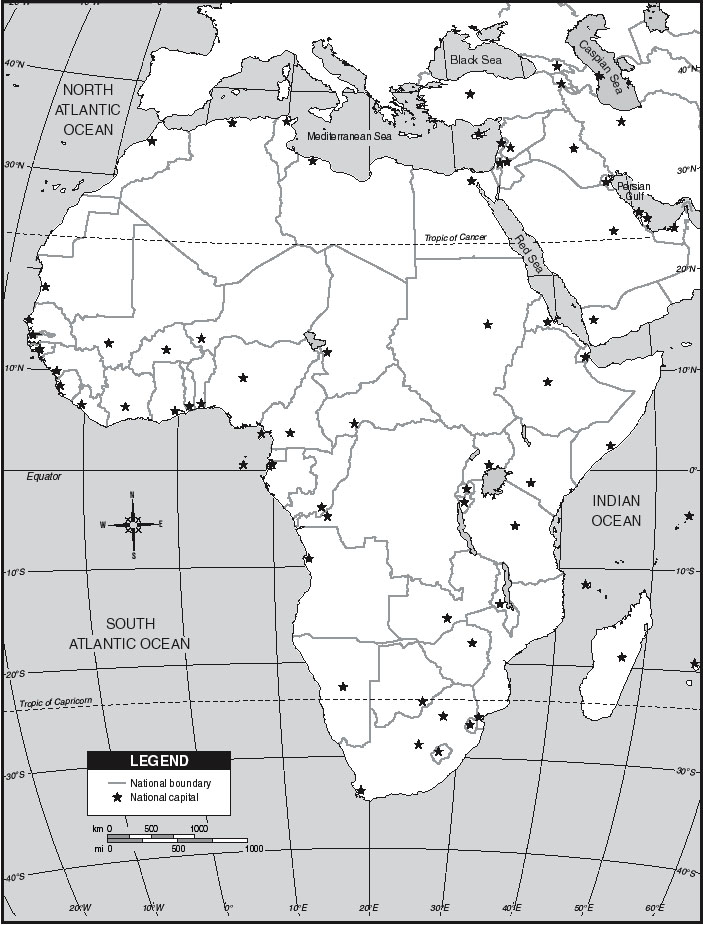
| TITLE | Un continent aux identités variées |
| UNIT/ACTIVITY NO. | L'Afrique: Activity 2 |
| TOPIC | Cultural geography |
| FUNCTION | Identify information and apply knowledge creatively |
| FOCUS | Understanding the varied cultural and social groups that exist in Africa, examining the diversity that exists on the continent |
I. BACKGROUND INFORMATION FOR TEACHERS
Teacher Instructions
| Step 1. | Prepare Trasparnecy 1, an African map with country outlines and capital cities indicated: Africa & Asia Political |
| Step 2. |
Choose from a list of 25-30 major people groups in Africa, one for each student or group of students. These will be the groups students will choose to study more in depth. A list of information about some groups can be found at: African People & Culture |
| Step 3. |
Prepare Transparency 2, a map of the languages spoken in Africa:
Languages of Africa Prepare copies of Handout 1 for each student. |
| Step 4. | Review the physical geography of Africa with students. Discuss the continent’s climate and the resulting vegetation. Specifically, students could use the Think Pair Share method to discuss question 2a from Handout 2, Activity 1. |
| Step 5. | Ask students the following questions, writing in the Know-Want to Know-Learned (KWL) chart developed in Activity 1 if appropriate:
|
| Step 6. | Show students Transparency 2. Invite students to comment on the diversity of languages and the extent to which this indicates the variety of ethnic groups. |
| Step 7. | Share the prepared list of ethnic groups with students. Ask students to match language groups with ethnic groups. These are the ethnic groups students will be studying in depth. |
| Step 8. | Allow students to choose which ethnic group they will study further in depth. Alternately, assign students to certain tribal groups. Some of the more widely known groups include Arabs, Ashanti, Bantu, Berbers, Bushmen, Dinka, Fulani, Ganda, Hamites, Hausa, Hottentot, Kikuyu, Luba, Lunda, Malinke, Moors, Nuer, Pygmies, Semites, Swahili, Tuareg, Xhosa, and Yoruba. The students’ task will be to create a mask from their tribe’s culture. Generally speaking, masks are a revered art form in most African societies and can represent a myriad of figures. |
| Step 9. | Give students Handout 1 and allow for independent work time. |
| Step 10. | Each student will present their mask and findings as time permits. Also allow time for class discussion for students to discuss similarities and differences in findings. What does this tell us about African tribal life? |
| Step 11. | Fill in the Learned (L) section of the KWL chart for Activity 2 to summarize important learnings. |
Materials
Students will need their physical maps from Activity 1, access to the Internet and/or books on African culture, heavy construction paper or tag board, string, scissors, glue, a hole-punch and markers, colored pencils or paint.
Notes
This lesson introduces students to the many cultural groups that exist in Africa. Only certain groups will be highlighted, but students will be asked to make connections between physical geography and cultural geography, using the art of different tribes.
Students should understand that Africa is isolated because of its geography. Major civilizations sprung up near coastlines, and river systems. Only the coastlines and rivers saw any major trade with outside countries, namely Mediterranean countries and Middle Eastern countries.
As a result of this isolation, literally thousands of different tribes developed in Africa. It is currently accepted by most scholars that approximately 2000 languages are currently spoken in Africa, almost a third of the number of languages spoken worldwide. Tribes developed independently of one another over centuries, but were dependent on each other for trade, commerce, and social and kinship ties.
Resources
Particularly good information for this activity can be found at:
http://www.zyama.com/
http://www.africaguide.com/culture/tribes/index.htm
http://www.uiowa.edu/~africart/toc/people.html
http://www.gateway-africa.com/tribe/
http://www.african-concept.com/masque-d-afrique.html
http://www.africawithin.com/
II. STUDENT ACTIVITY HANDOUT
Handout 1
Nom:
Date:
Les masques africains
La tribu africaine que j’étudie: ________________________________________
|
La région d’Afrique |
|
|
Population |
|
|
Langues |
|
|
Les tribus voisines |
|
|
Les types d’art/les symboles et images |
|
|
L’histoire |
|
|
La religion
|
|
Après avoir complété le tableau, choisissez une image et créez un masque qui représente un aspect de votre groupe. Pourquoi avoir choisi cette image? Quelle est la part d’authenticité et d’imaginaire de votre masque?
III. VISUAL AIDS FOR TEACHERS
Transparency 1
Transparency 2
IV. FOLLOW UP ACTIVITIES
Have students research the cultural myths and oral traditions (stories) of a particular tribal group. Students could write plays based on a traditional story and perform them for their class members.
Using a local university or other community resource, invite African nationals into the classroom to provide firsthand accounts of the diversity that exists in Africa. It would be particularly interesting if these guests were from West Africa and could speak French with students.